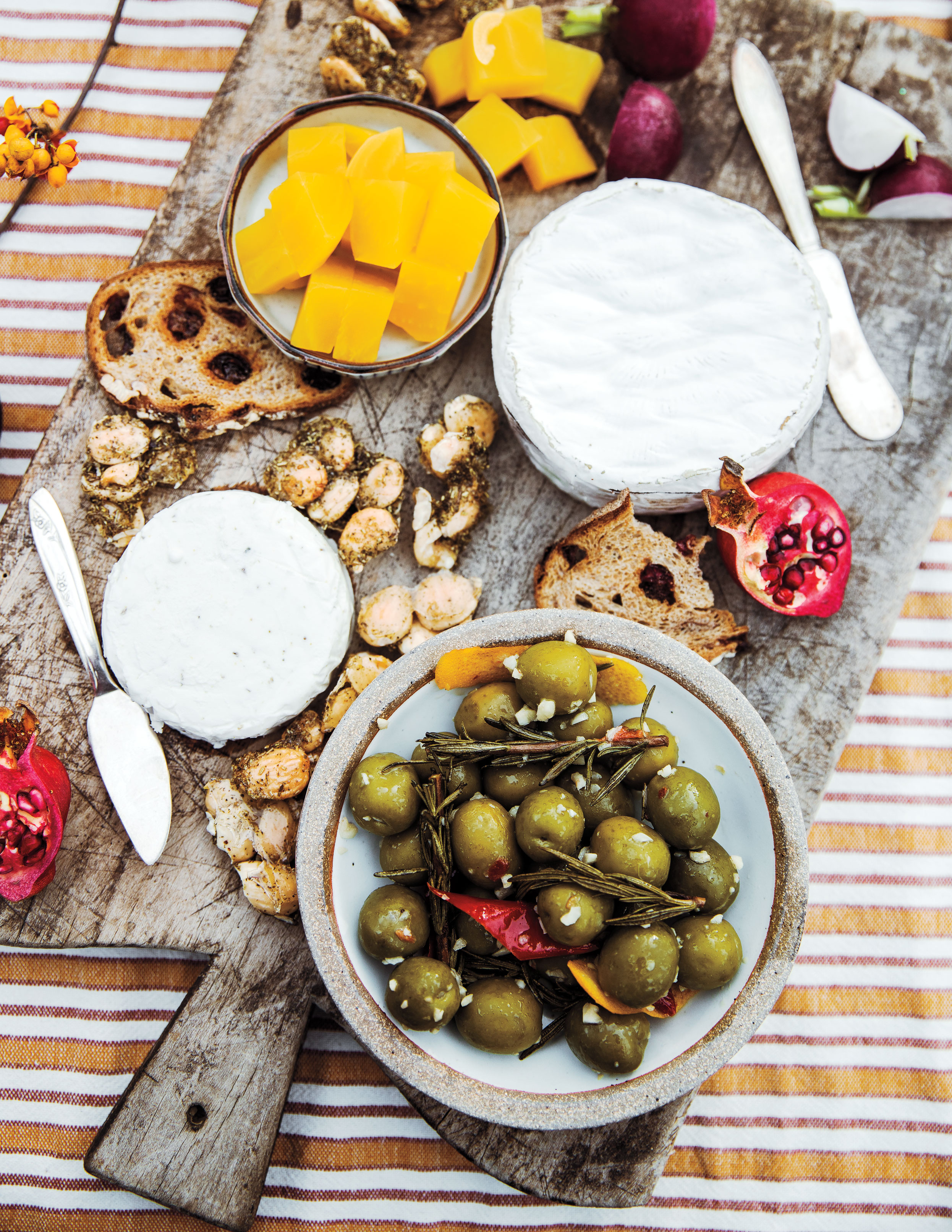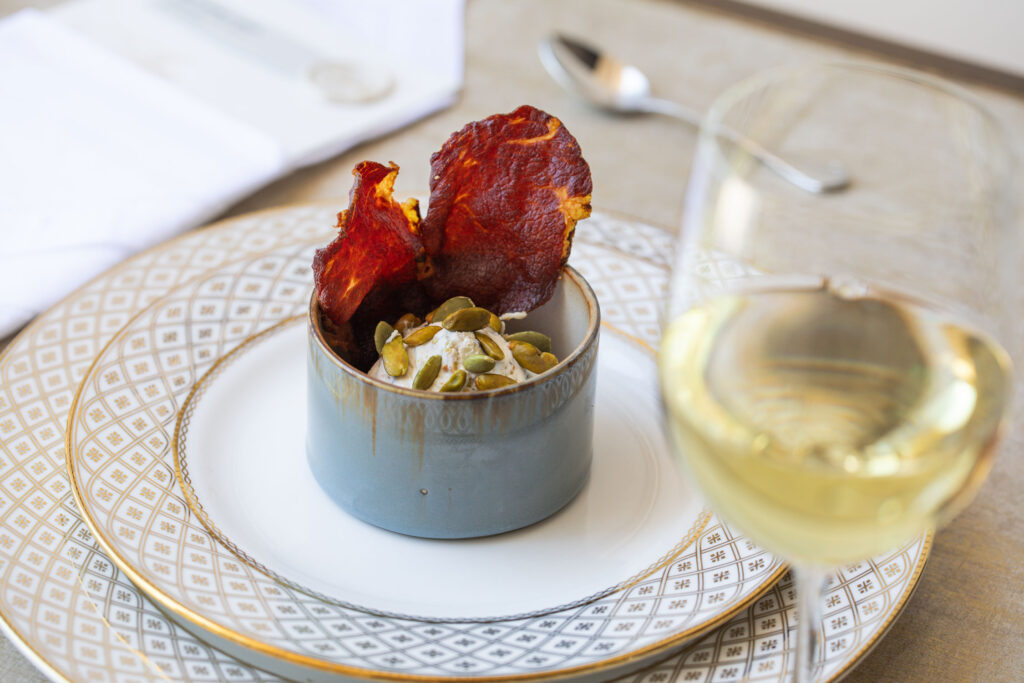As far as we’re concerned, wine and cheese is like the salt and pepper of pairings. A great glass of vino and charcuterie board are in lockstep, making it almost unnatural to have one without the other. But which are the best pairings? After all, with so many cheeses and varietals to choose from, finding the perfect match can feel like a huge undertaking. But, if you ask food and beverage pros, it doesn’t have to be that way. According to Chef Jesse Mallgren, who is the executive chef at Jordan Vineyard & Winery in Healdsburg, it’s all about taking chances.
“Everyone’s palate is different, and the most important thing is to have fun exploring different pairings,” he explains. “Even if a combination doesn’t quite work, it can spark great conversation and help you discover which flavor profiles you like and don’t like together.”
Chef Patrick Prager, executive chef of Silverado Resort in Napa Valley, agrees but cautions there are some small adjustments that can “make a big difference” in how both the wine and cheese show up in a pairing. “Take your cheese out of the fridge at least an hour before serving to let it soften and open up, just like you might decant a wine,” he recommends. “Room temperature brings out the nuance and texture, making the pairing much more expressive.” Another tip to follow? Add complementary bites. Wine and cheese are the salt and pepper of pairings, but nuts, dried fruit, and even crackers can help round out the experience.
While the ultimate wine and cheese pairing might be subjective, you’re still probably looking for a place to start. To help, a few insiders are sharing the mouthwatering combinations that always have them begging for more.
Kendall Busby
Love Chardonnay? Feast on Fromage Blanc
You don’t need to go to a specialty shop to find a delicious duo: Mallgren says chardonnay and fromage blanc go great together. “The Jordan Chardonnay is made in a Burgundian-style with subtle oak, crisper minerality and bright acidity on the finish pairs beautifully with soft cheeses,” he explains.
Fromage blanc is pretty easy to find at the grocery store, but you can always make store-bought feel special. For an insta-zhuzh, Mallgren suggests Cervelle de Canut, a classic French fromage blanc spread elevated with toasted Sicilian pistachios, thyme and a crunchy, savory garnish. “Its creamy texture and delicate balance of salty and nutty flavors make it a versatile accompaniment to our food-friendly chardonnay,” he says.
Love Sauvignon Blanc? Go for Goat Cheese
Since some chardonnays can taste ultra-oaky, some wine drinkers might find sauvignon blanc an easier-to-pair grape. In that case, grab some goat cheese. “The tangy, fresh flavors of goat cheese are nicely complemented by the citrusy and grassy notes of sauvignon blanc, creating a bright and refreshing combination,” explains Chef Forest Kellogg, estate chef at J Vineyards & Winery in Healdsburg. If you want to add a little oomph to this pairing, try drizzling light, floral-forward honey over the cheese and add some dried apricots.
Love Champagne? Try it With Triple Cream
It doesn’t matter if you enjoy a glass on its own or with scrumptious seafood, one thing’s for certain: Bubbles are basically always a good idea. If you want to pair your sparkling sip with cheese, Chef Mallgren points to triple cream. “It’s a standout pairing that lies in the contrast of the creamy, rich texture of the cheese balanced by the crisp bubbly Champagne,” he explains. By definition, triple cream is a cheese that has extra cream and contains more than 75 percent fat so look for mascarpone as well as certain types of Brie and Camembert. “The richness of Brie calls for a sharper sparkling wine to slice through this creamy texture,” Chef Kellogg says. (Psst… if “triple cream” is mentioned on the label, it’ll be a great fit.)

courtneyk/Getty Images
Love Big, Bold Cabernet? Exercise Caution
Craving a glass of cabernet sauvignon with a silky, creamy cheese? Not so fast. “Full-bodied reds can clash with many cheeses, especially the delicate or creamy ones,” Chef Prager says. “They don’t play well with high-fat, bloomy-rind, or fresh cheeses, which lack the protein and salt to balance the wine’s structure.” The tannins you typically taste in a Cabernet Sauvignon or Syrah, he explains, can overwhelm soft cheeses and create an unpleasant metallic or chalky taste. “A better approach is to save big reds for firm, aged cheeses like aged gouda, cheddar, or Parmigiano-Reggiano,” he explains.
Love Pinot Noir? Chow Down on Cheddar
Speaking of cheddar, Chef Prager says pinot noir works well with this hard cheese. He particularly enjoys a glass of pinot with cheddar and apple tart—layers of cheddar cheese mousse, apple compote, aged cheddar crumble, and dehydrated cheddar powder. “The richness and sharpness of cheddar play beautifully with the tart-sweet apple,” he says. “[Try] a pinot noir with finesse and acidity, like Lichen Estate Pinot Noir or Flowers Pinot Noir.”

Thomas J. Story
Still Undecided? Have Fun
Don’t worry if you didn’t see a duo that whets your appetite: These pros are all about experimenting with pairings. For guidance, Chef Prager points that what grows together often goes together. “Regional pairings are often naturally harmonious because the wine and cheese share a sense of place,” he says. For example, manchego with Rioja (Tempranillo) from Spain or Pecorino Toscano with a rustic Chianti from Tuscany.”
Meanwhile, winemaker Sam Bilbro has a “looser” approach. “Pair whatever it is you like and enjoy it,” says Bilbro, who works for Overshine Wine Co., a wine hospitality group that includes brands like Idlewild, Overshine, and Comunitá. “Think about contrast like a crisp wine with a creamy cheese or echo [flavors] with a nutty wine and an aged cheese. But mostly, keep it loose.”
At parties, Bilbro loves to wow a crowd with “heaping plates of salumi and cheese” so everyone can find a winning combo. “That kind of shared experience tends to create the most surprising and delightful pairings naturally,” he reasons. “This pairs beautifully with the mix of a lineup of wines where it’s more about the moment than the match.”
But remember: Pairings are subjective, so make sure you like what you’re eating and drinking.
“Start with what you like, and take note of what you smell, taste, and feel,” says Chef Kellogg. “From there, try the same wine with a few different cheeses to see how those flavors alter your experience tasting the wine.”


